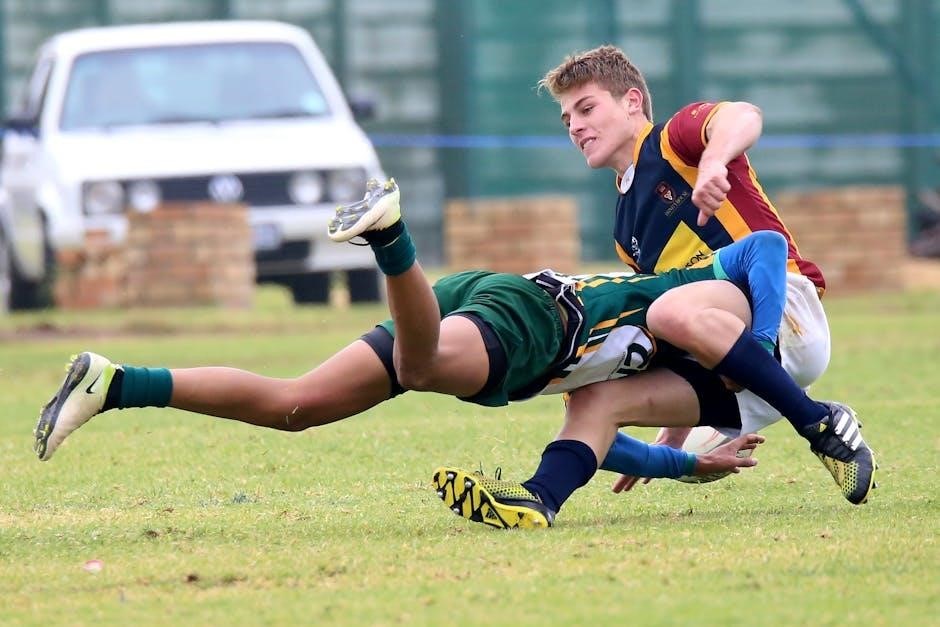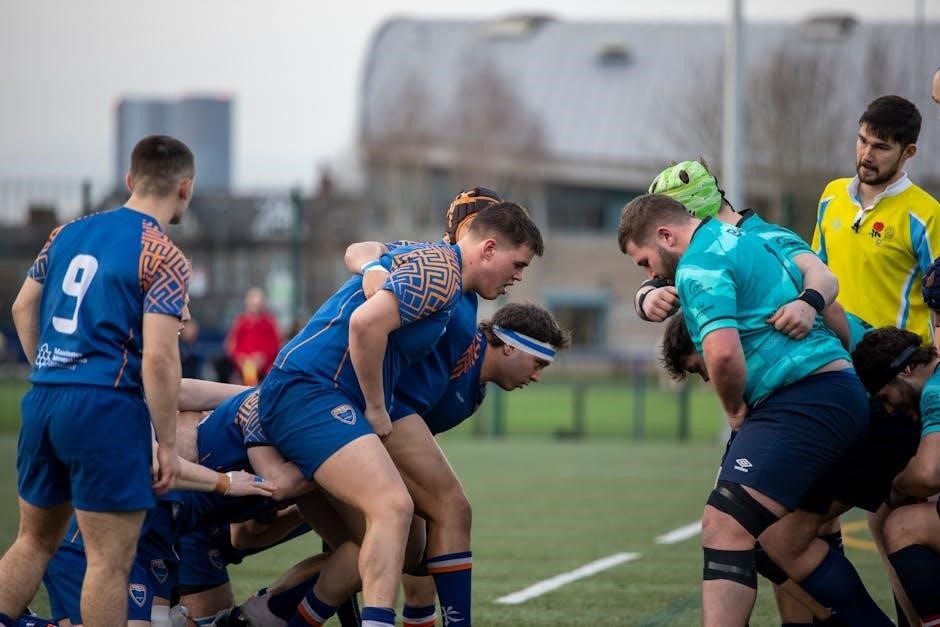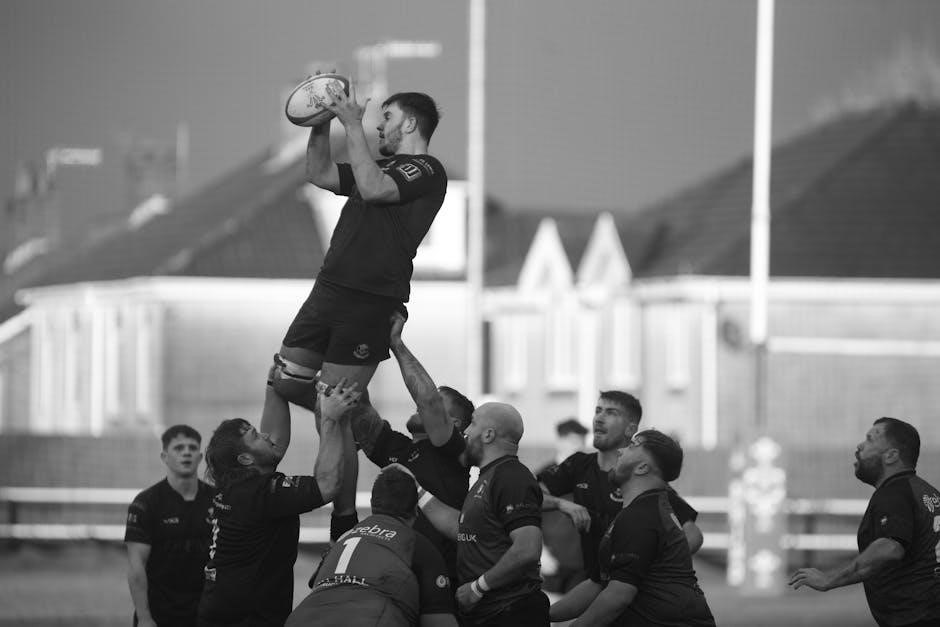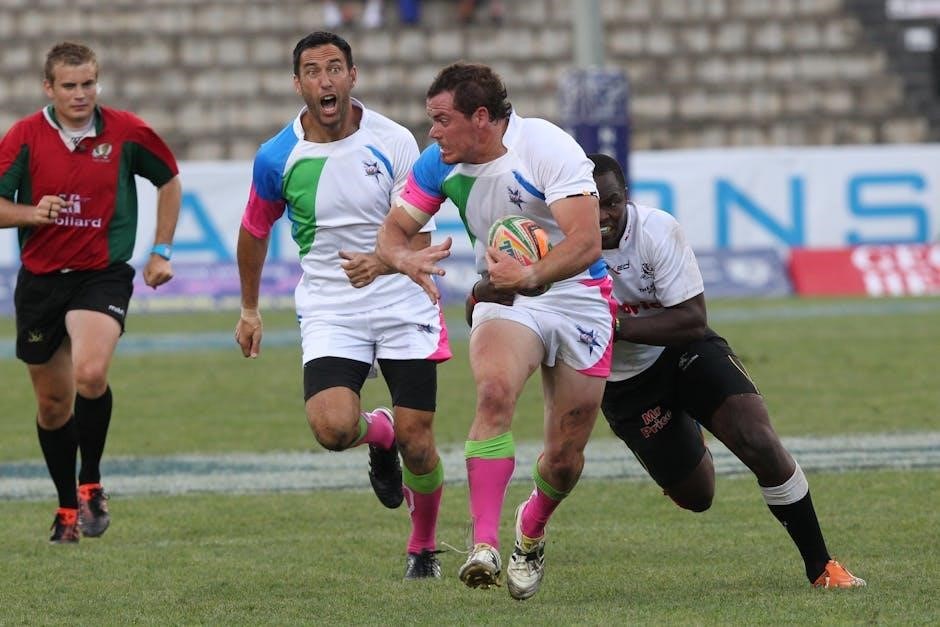rugby league training program pdf
A comprehensive Rugby League Training Program in PDF format offers structured guidance, enhancing physical and technical skills through detailed drills, exercises, and periodized plans for optimal performance.
1.1 Overview of Rugby League Training
Rugby league training encompasses a combination of strength, conditioning, speed, agility, endurance, and technical skills. Programs are designed to enhance physical attributes and sport-specific abilities, ensuring players meet the demands of the game. Training is periodized to optimize performance, incorporating drills and exercises tailored to improve power, speed, and agility. The integration of these components fosters well-rounded development, preparing athletes for the intensity and tactical requirements of rugby league. A structured approach ensures progressive improvement and reduces injury risk.
1.2 Importance of Structured Training Programs
A well-structured training program is essential for rugby league players to ensure progressive development and peak performance. It provides a clear roadmap, avoiding random training and ensuring all physical and technical aspects are addressed. Structured programs enhance consistency, reduce injury risks, and optimize season preparation. They also allow coaches to monitor progress and adapt strategies, ensuring players are physically and mentally prepared for competition. A structured approach is critical for achieving long-term success in rugby league.
1.3 Benefits of Using a PDF Training Program
A PDF training program offers unparalleled convenience and accessibility, allowing players and coaches to download and use structured plans anytime, anywhere. It provides a clear, organized approach to development, ensuring all aspects of rugby league training are covered. PDFs often include detailed drills, exercises, and progress tracking, making them a valuable resource for consistent improvement. Their affordability and ease of sharing make them a cost-effective solution for teams and individuals seeking comprehensive training guidance.
Components of a Rugby League Training Program
A Rugby League training program incorporates strength, conditioning, speed, agility, endurance, and technical skills, ensuring a well-rounded approach to player development and performance enhancement.
2.1 Strength and Conditioning
Strength and conditioning are core components of rugby league training, focusing on building muscular endurance, power, and hypertrophy. Programs often include resistance exercises, plyometrics, and functional movements. Periodization ensures progressive overload, preventing plateaus and optimizing performance. Exercises like scapular push-ups and flutters target specific muscle groups, enhancing overall athleticism. A well-structured strength and conditioning regimen supports injury prevention and improves on-field capabilities, making it essential for players at all levels.
2.2 Speed and Agility Training
Speed and agility training is vital for rugby league players, enhancing explosive acceleration and quick directional changes. Sprint drills, such as stride length and rate exercises, improve raw speed, while agility drills like side steps and shuttle runs refine agility. These exercises are often combined in dynamic drills to mimic game scenarios. Flexibility and proper technique are emphasized to optimize performance and prevent injuries. Progressive overload ensures continued improvement, making speed and agility training a cornerstone of rugby league development.
2.3 Endurance and Aerobic Fitness
Endurance and aerobic fitness are essential for rugby league players to maintain high-intensity efforts over the full 80-minute game. Training programs include aerobic exercises like running and cycling, as well as high-intensity interval training (HIIT) to improve anaerobic endurance. Periodized plans ensure players peak at the right time, while microcycles help balance intensity and recovery. These strategies enhance stamina, allowing players to perform at optimal levels throughout the season and reduce the risk of fatigue-related injuries.
2.4 Technical and Tactical Skills
Developing technical and tactical skills is crucial for rugby league success. Training programs include drills for evasion techniques, passing accuracy, and tackling efficiency. Players learn to execute plays like offloads and dummy runs effectively. Tactical strategies focus on decision-making, positional awareness, and teamwork. These skills are refined through game-specific scenarios and video analysis, ensuring players can adapt to match situations and outperform opponents. Mastery of these elements enhances overall performance and contributes to a cohesive team strategy.
2.5 Injury Prevention and Recovery
Injury prevention and recovery are vital components of rugby league training programs. Incorporating flexibility, mobility, and strength exercises helps reduce injury risks. Recovery techniques such as foam rolling, ice baths, and active recovery sessions are emphasized to enhance muscle repair and maintain performance levels. These strategies ensure players can train consistently and return to competition in optimal condition, minimizing downtime and prolonging careers.

Strength and Conditioning in Rugby League
Strength and conditioning are foundational for rugby league, focusing on building power, strength, and agility. Programs include targeted exercises and periodized plans to optimize muscle endurance and explosive power.
3.1 Muscular Analysis of Rugby League Skills
Rugby league skills rely heavily on specific muscle groups, including the legs, core, and upper body. Strength in the quadriceps, hamstrings, and glutes is crucial for sprinting, tackling, and explosive movements. The core muscles stabilize the body, enhancing endurance and agility. A muscular analysis helps coaches design targeted exercises, ensuring players develop the necessary power, speed, and strength for optimal performance. PDF training programs often include detailed exercises tailored to these muscle groups, fostering a balanced and effective physique for the demands of the sport.
3.2 Planning a Strength Training Program
Planning a strength training program for rugby league involves assessing player needs, setting goals, and structuring exercises. Periodization is key, with phases focusing on hypertrophy, strength, and power. A well-designed program includes compound movements like squats and deadlifts, alongside sport-specific exercises. Progression is tailored to individual and team requirements, ensuring peak performance during the season. PDF guides often provide structured templates, making it easier to organize and track training, while ensuring a balanced approach to building the necessary strength for rugby league demands.
3.3 Sample 12-Week Pre-Season Strength Program
A sample 12-week pre-season strength program for rugby league focuses on building foundational strength, power, and hypertrophy. The program is divided into phases: Weeks 1-4 focus on hypertrophy with higher volume and moderate intensity, Weeks 5-8 shift to strength with lower reps and higher loads, and Weeks 9-12 emphasize power and speed-strength. Key exercises include squats, deadlifts, bench presses, and pull-ups. Progression is structured to ensure peak physical readiness for the season, with detailed sets, reps, and intensity outlined in PDF guides for clarity and ease of implementation.

Speed and Agility Training
Speed and agility training enhances quickness, acceleration, and directional changes, crucial for rugby league performance. Sprint drills, agility exercises, and combined workouts optimize field effectiveness, detailed in PDF guides.
4.1 Sprint Training for Explosive Speed
Sprint training focuses on developing explosive speed through targeted drills. Emphasizing the ATP-PC system, exercises like butt kicks, bounding, and pawing improve stride length and rate. These drills enhance acceleration and power, essential for breaking tackles and covering distances quickly on the field. Incorporating high-intensity intervals and resisted sprints further maximizes speed gains. A well-structured sprint program, detailed in PDF guides, ensures players achieve peak performance and explosive speed during matches.
4.2 Agility Drills for Quick Changes of Direction
Agility drills are essential for improving quick changes of direction, a critical skill in rugby league. Drills like side steps, swerves, and figure-eight runs enhance players’ ability to evade opponents. These exercises, often detailed in training program PDFs, focus on rapid reactions and sharp movements. By incorporating cone exercises and shuttle runs, players develop the agility needed to outmaneuver defenders and maintain control during high-intensity game situations, ensuring effective performance on the field.
4.3 Combining Speed and Agility in Drills
Combining speed and agility in drills is crucial for rugby league players to master quick directional changes and explosive acceleration. Drills like cone weaves, reactive sprints, and shuttle runs integrate both components, enhancing game-specific movements. These exercises, often outlined in training program PDFs, improve reaction time and adaptability, allowing players to seamlessly transition between speed and agility during matches. This holistic approach ensures athletes can maintain high performance under pressure, making them more effective on the field.

Periodization of Training
Periodization of training in rugby league involves organizing the season into phases, ensuring a balance between physical fitness and skill development to achieve peak performance during competitions.
5.1 Understanding Training Periodization
Training periodization in rugby league involves structuring the season into phases to optimize performance. It ensures a balance between building fitness and allowing recovery, preventing overtraining. The process typically divides the year into pre-season, in-season, and off-season periods, each with specific goals. This approach helps athletes peak physically and mentally for competitions while reducing injury risks. By aligning training with competition demands, periodization enhances strength, endurance, and skill development, ensuring players are prepared for the rigors of the game. Proper planning is key to achieving long-term success.
5.2 Seasonal Training Plan
A seasonal training plan for rugby league is designed to align with the competition calendar, ensuring players are prepared for each phase. It typically includes a pre-season focus on building strength and endurance, an in-season emphasis on maintaining fitness and addressing specific game demands, and an off-season dedicated to recovery and rebuilding. Each phase is structured to optimize performance, with detailed drills, exercises, and recovery strategies outlined in the PDF program. This approach ensures a seamless transition between training and competition periods.
5.3 Microcycle and Macrocycle Planning
Microcycle and macrocycle planning are essential for structuring rugby league training programs. A microcycle typically lasts 1-4 weeks, focusing on specific training objectives like strength or endurance. The macrocycle spans the entire season, dividing it into phases such as pre-season, in-season, and off-season. This periodized approach ensures players peak at critical moments. The PDF program provides detailed templates and examples, helping coaches balance training loads and recovery to optimize performance and reduce injuries.

Technical and Tactical Skills Development
Developing technical and tactical skills enhances rugby league performance. Focus on evasion techniques, passing accuracy, and defensive strategies. The PDF program offers drills to refine these skills effectively, improving game execution and decision-making under pressure.
6.1 Evasion Skills and Techniques
Evasion skills are crucial for rugby league players to outmaneuver opponents. Techniques like side steps, swerves, fends, and change of pace are essential. The PDF program includes drills to master these skills, improving balance, agility, and decision-making. Players learn to execute evasive moves effectively under pressure, enhancing their ability to break through defensive lines and create attacking opportunities. Consistent practice of these techniques ensures players develop the reactivity and vision needed for elite performance.
6.2 Passing and Handling Drills
Passing and handling drills are fundamental to rugby league success. The PDF program includes exercises like grip and catch, draw and pass, and 2v1 passing to improve accuracy and teamwork. Players develop the ability to deliver precise, timed passes under pressure while maintaining ball control. These drills enhance coordination, decision-making, and communication, ensuring seamless play execution. The program also incorporates warm-up routines and progress tracking to refine these essential skills effectively.
6.3 Tackling and Defensive Techniques
Tackling and defensive techniques are critical in rugby league, requiring precision and safety. The PDF program includes drills like front-on tackles, side-on tackles, and defensive line setups to improve impact and control. Players learn proper body positioning, wrapping, and driving techniques to minimize injuries. The program also emphasizes defensive strategies, such as reading plays and maintaining defensive lines, ensuring a robust and organized team defense. These drills are designed to enhance both individual and team defensive capabilities effectively.
6.4 Attacking and Defensive Strategies
Attacking and defensive strategies are vital for success in rugby league, focusing on effective play structures and adaptable systems to outmaneuver opponents. The PDF program provides drills to enhance attacking techniques, such as dummy runs and late offloads, while defensive strategies emphasize strong line defense and pressure points. Players learn to exploit defensive gaps and maintain defensive integrity through structured drills and scenario-based training. This comprehensive approach ensures teams can adapt strategies to dominate both sides of the ball effectively.

Injury Prevention and Recovery Strategies
Injury prevention and recovery strategies in rugby league training programs emphasize flexibility, strength, and recovery techniques to minimize injuries and optimize player performance effectively.
7.1 Importance of Injury Prevention
Injury prevention is crucial for reducing risks, enhancing performance, and prolonging player careers. Effective strategies include strength training, flexibility exercises, and recovery techniques to minimize physical stress and improve resilience. Preventing injuries ensures consistent player availability, reduces medical costs, and maintains team competitiveness. Incorporating injury prevention into training programs is essential for long-term success and optimal performance in rugby league.
7.2 Flexibility and Mobility Exercises
Flexibility and mobility exercises are essential for improving range of motion, reducing injury risk, and enhancing athletic performance. Dynamic stretching, foam rolling, and targeted movements like scapular push-ups and spiderman crawls are commonly used. These exercises promote joint health, muscle elasticity, and optimal movement patterns. Incorporating flexibility routines into rugby league training ensures players maintain agility, power, and endurance, supporting overall performance and injury prevention goals throughout the season.
7.3 Recovery Techniques for Optimal Performance
Recovery techniques are vital for maintaining peak performance in rugby league. Strategies include stretching, foam rolling, and active recovery sessions to reduce muscle soreness. Periodized training plans incorporate rest days and low-intensity activities to prevent overtraining. Nutrition and hydration play a key role, with tailored meal plans and hydration strategies supporting muscle repair. These methods ensure players return to training refreshed, ready to maximize their potential and avoid injuries. Effective recovery is as important as the training itself in achieving long-term success.

Nutrition and Hydration for Rugby League
A well-structured meal plan and hydration strategy are essential for optimizing performance. Tailored nutrition plans ensure energy levels are maintained, supporting intense training and recovery effectively in Rugby League.
8.1 Meal Planning for Athletes
Proper meal planning is crucial for athletes, ensuring they fuel their bodies for peak performance. A balanced diet rich in proteins, carbohydrates, and healthy fats supports energy levels and recovery. Timing meals around training sessions, including pre- and post-workout nutrition, maximizes results. Hydration is equally vital, with personalized plans to match training intensity. Downloadable PDF guides provide structured meal ideas, making it easier for athletes to maintain optimal nutrition throughout their Rugby League training program.
8.2 Hydration Strategies for Training
Effective hydration strategies are essential for athletes to maintain performance and prevent dehydration. Athletes should drink 500ml of water or a sports drink 30 minutes before training. Monitoring urine color can help assess hydration levels, aiming for a pale yellow shade. During sessions, regular sips of water or electrolyte-rich drinks are recommended, especially in hot conditions. Post-training, replenishing lost fluids and electrolytes is crucial. Downloadable PDF guides provide detailed hydration plans tailored to Rugby League training demands, ensuring optimal performance and recovery.
Age-Specific Training Considerations
Age-specific training ensures programs are tailored to developmental stages, focusing on youth development for younger players and advancing to senior levels, promoting safe and effective progression in Rugby League.
9.1 Youth Development Programs
Youth development programs in Rugby League focus on building fundamental skills and physical preparation for players aged 13 and above. These programs emphasize safety, technique, and progressive overload, ensuring young athletes develop strength, speed, and agility. Structured lesson plans and game-based activities promote engagement and skill mastery. Coaches tailor training to age-specific needs, fostering confidence and competence over an 8-week period, laying the foundation for future success in the sport. Adjustments are made based on individual fitness levels to ensure optimal growth and injury prevention.
9.2 Amateur and Professional Training Differences
Amateur and professional Rugby League training programs differ significantly in intensity, complexity, and resources. Professional programs feature periodized plans, advanced conditioning, and specialized coaching, while amateur programs focus on skill development and safety. Professionals often have access to dedicated strength coaches and sports scientists, whereas amateurs may rely on volunteer coaches. Training loads, recovery strategies, and technical drills are tailored to the demands of professional competition, whereas amateur programs prioritize enjoyment, foundational skills, and progressive development to prepare players for higher levels.

Mental Preparation and Mindset
Mental preparation is crucial for Rugby League success, focusing on building resilience, focus, and confidence. Psychological techniques enhance performance, ensuring players stay motivated and composed under pressure.
10.1 Building Mental Toughness
Mental toughness is vital for Rugby League players to perform under pressure. Techniques like visualization, positive self-talk, and emotional control help build resilience. Structured mental drills in PDF programs guide players to stay focused and composed. Goal-setting strategies and mindfulness practices are also included to enhance psychological strength. These methods enable players to maintain confidence, overcome setbacks, and deliver peak performance consistently. A strong mindset is as crucial as physical skill in achieving success on the field.
10.2 Psychological Techniques for Performance
Psychological techniques play a crucial role in enhancing Rugby League performance. Visualization, positive self-talk, and emotional control are key methods to improve focus and composure. Goal-setting strategies help players maintain motivation, while mindfulness practices reduce stress. These techniques, often outlined in PDF training programs, enable athletes to stay mentally sharp and adapt to high-pressure situations. By integrating these strategies, players can optimize decision-making, resilience, and overall performance, giving them a competitive edge on the field. Mental preparation is as vital as physical training for success in Rugby League.
Coaching and Leadership in Training
Effective coaching strategies and leadership are essential for successful Rugby League training. Coaches organize sessions, provide feedback, and inspire players to achieve their potential, fostering unity and a winning mindset.
11.1 Effective Coaching Strategies
Effective coaching in Rugby League involves structured session planning, clear communication, and the use of drills to enhance skills. Coaches utilize periodized training plans, focusing on specific physical and technical development. They incorporate game-based scenarios to improve decision-making and teamwork. Regular feedback and performance analysis are essential to tailor training programs to individual and team needs. By fostering a positive and competitive environment, coaches ensure players reach their full potential, preparing them for the demands of the sport at all levels;
11.2 Drills and Games for Skill Development
Detailed drills and games in a Rugby League training program focus on improving evasion, passing, and defensive techniques. Evasion drills like side steps and swerves enhance agility, while passing accuracy exercises ensure precise ball control. Small-sided games and 2v1 scenarios simulate match conditions, fostering decision-making and teamwork. These structured activities, outlined in PDF guides, help players master core skills and adapt to game situations, ensuring comprehensive skill development tailored to individual and team needs.
11.3 Case Studies of Successful Programs
Real-world examples of effective Rugby League training programs highlight their impact on player performance. The Brisbane Broncos Development Program, for instance, combines strength exercises with skill drills, resulting in improved match readiness. Similarly, the NRL Coaching Manual outlines session plans that enhance endurance and technical proficiency. These case studies demonstrate how structured, periodized training can reduce injuries and elevate team success, offering practical insights for coaches and players seeking proven strategies for skill and physical development.
A well-structured Rugby League Training Program enhances performance, combining physical conditioning with technical skill development. PDF guides provide coaches and players with effective, organized strategies for success.
12.1 Summary of Key Points
A Rugby League Training Program in PDF format is essential for improving performance, offering structured plans for strength, speed, agility, and technical skills. Periodization ensures optimal physical development, while nutrition and hydration strategies support recovery. Age-specific training and mental preparation are highlighted as critical components. These programs provide coaches and players with a clear roadmap to enhance game-specific abilities, ensuring a holistic approach to reaching peak performance and achieving success in the sport.
12.2 Final Thoughts on Effective Training
Effective Rugby League Training requires a balanced approach, combining strength, speed, agility, and technical skills. Structured PDF programs offer clarity and progression, ensuring players achieve peak performance. Proper periodization, nutrition, and recovery are vital for long-term success. Mental preparation and coaching leadership further enhance player development. By adhering to these principles, athletes can maximize their potential, ensuring sustainable growth and success in the sport.